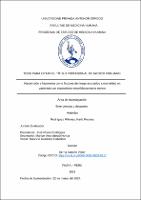Mostrar el registro sencillo del ítem
Hipotensión e hipoxemia como factores de riesgo asociados a mortalidad en pacientes con traumatismo encefalocraneano severo
| dc.contributor.advisor | Serna Alarcón, Víctor | |
| dc.contributor.author | Rodríguez Millones, Karla Roxana | |
| dc.creator | Rodríguez Millones, Karla Roxana | |
| dc.date.accessioned | 2024-04-04T22:13:03Z | |
| dc.date.available | 2024-04-04T22:13:03Z | |
| dc.date.issued | 2024 | |
| dc.identifier.uri | https://hdl.handle.net/20.500.12759/26191 | |
| dc.description.abstract | OBJETIVO: Comprobar si la asociación de hipotensión e hipoxemia genera mayor riesgo de mortalidad que de forma aislada, en pacientes con TEC severo de Piura. MATERIALES Y MÉTODOS: Se realizó un estudio tipo cohorte retrospectivo en el cual se incluyeron 168 pacientes con TEC severo que cumplían con los criterios de selección. Se dividieron en 3 grupos de estudio (56 con hipotensión, 56 con hipoxemia y 56 con ambos) y se realizó un seguimiento en el historial clínico para comprobar la presencia o ausencia de mortalidad hasta los 30 días del ingreso. RESULTADOS: La mortalidad en el grupo con hipotensión e hipoxemia fue de 58.9%(n=33), hipotensión 35.7%(n=20) e hipoxemia 25%(n=14) con diferencia significativa en la prueba chi cuadrado de Pearson (p=0.001). Cuando comparamos la asociación de hipotensión e hipoxemia con los pacientes que solo presentaron hipotensión se obtuvo [RR= 1.65 (IC 95% 1.09 – 2.49) (p=0.014)] y cuando se comparó con los pacientes que solo presentaron hipoxemia, se obtuvo [RR= 2.36 (IC 95% 1.42 – 3.90) (p<0.001)]. Se realizó un análisis multivariado de las variables intervinientes con diferencia significativa y se determinó que los pacientes con hipotensión e hipoxemia son 3,24 veces más propensos a fallecer en comparación de los que tienen hipoxemia solo, cuando es ajustado por las variables: presencia de hemorragia cerebral [RR = 3.91 (IC 95% 2.36 – 6.50) (p<0.001)] y equilibrio de ácido base = alcalosis respiratoria [RR = 2.47 (IC 95% 1.34 – 4.55) (p=0.004)]. CONCLUSIÓN: La asociación de hipotensión e hipoxemia sí genera mayor riesgo de mortalidad que de forma aislada, en pacientes con diagnóstico de TEC severo de Piura | es_PE |
| dc.description.abstract | OBJECTIVE: To check whether the association of hypotension and hypoxemia generates a greater risk of mortality than in isolation, in patients with severe TBI from Piura. MATERIALS AND METHODS: A retrospective cohort study was conducted, including 168 patients with severe TBI who met the selection criteria. They were divided into 3 study groups (56 with hypotension, 56 with hypoxemia, and 56 with both), and their medical records were followed to confirm the presence or absence of mortality within 30 days of admission. RESULTS: Mortality in the group with hypotension and hypoxemia was 58.9% (n=33), hypotension 35.7% (n=20) and hypoxemia 25% (n=14) with a significant difference in the Pearson chi-square test (p =0.001). When we compared the association of hypotension and hypoxemia with patients who only presented hypotension, we obtained [RR= 1.65 (95% CI 1.09 – 2.49) (p=0.014)] and when we compared it with patients who only presented hypoxemia, we obtained [ RR= 2.36 (95% CI 1.42 – 3.90) (p<0.001)]. A multivariate analysis of the intervening variables was carried out with a significant difference and it was determined that patients with hypotension and hypoxemia are 3.24 times more likely to die compared to those with hypoxemia alone, when adjusted for the variables: presence of hemorrhage brain [RR = 3.91 (95% CI 2.36 – 6.50) (p<0.001)] and acid-base balance = respiratory alkalosis [RR = 2.47 (95% CI 1.34 – 4.55) (p=0.004)]. CONCLUSION: The association of hypotension and hypoxemia does generate a greater risk of mortality than in isolation, in patients diagnosed with severe TBI in Piura | es_PE |
| dc.description.uri | Tesis | es_PE |
| dc.format | application/pdf | es_PE |
| dc.language.iso | spa | es_PE |
| dc.publisher | Universidad Privada Antenor Orrego | es_PE |
| dc.relation.ispartofseries | T_MEDP_462 | |
| dc.rights | info:eu-repo/semantics/openAccess | es_PE |
| dc.rights.uri | https://creativecommons.org/licenses/by/4.0/ | es_PE |
| dc.source | Universidad Privada Antenor Orrego | es_PE |
| dc.source | Repositorio Institucional - UPAO | es_PE |
| dc.subject | Hipotensión | es_PE |
| dc.subject | hipoxemia | es_PE |
| dc.subject | traumatismo cerebral severo | es_PE |
| dc.title | Hipotensión e hipoxemia como factores de riesgo asociados a mortalidad en pacientes con traumatismo encefalocraneano severo | es_PE |
| dc.type | info:eu-repo/semantics/bachelorThesis | es_PE |
| thesis.degree.level | Título Profesional | es_PE |
| thesis.degree.grantor | Universidad Privada Antenor Orrego. Facultad de Medicina Humana | es_PE |
| thesis.degree.name | Médico Cirujano | es_PE |
| thesis.degree.discipline | Medicina Humana | es_PE |
| dc.subject.ocde | https://purl.org/pe-repo/ocde/ford#3.02.27 | es_PE |
| renati.advisor.orcid | https://orcid.org/0000-0002-9803-6217 | es_PE |
| renati.author.dni | 77822094 | |
| renati.advisor.dni | 70077704 | |
| renati.type | https://purl.org/pe-repo/renati/type#tesis | es_PE |
| renati.level | https://purl.org/pe-repo/renati/level#tituloProfesional | es_PE |
| renati.discipline | 912016 | es_PE |
| renati.juror | Flores Rodríguez, José | |
| renati.juror | Arrunátegui Novoa, Manuel | |
| renati.juror | Gutiérrez Caballero, Mauricio | |
| dc.publisher.country | PE | es_PE |
Ficheros en el ítem
Este ítem aparece en la(s) siguiente(s) colección(es)
-
Medicina Humana [2984]




